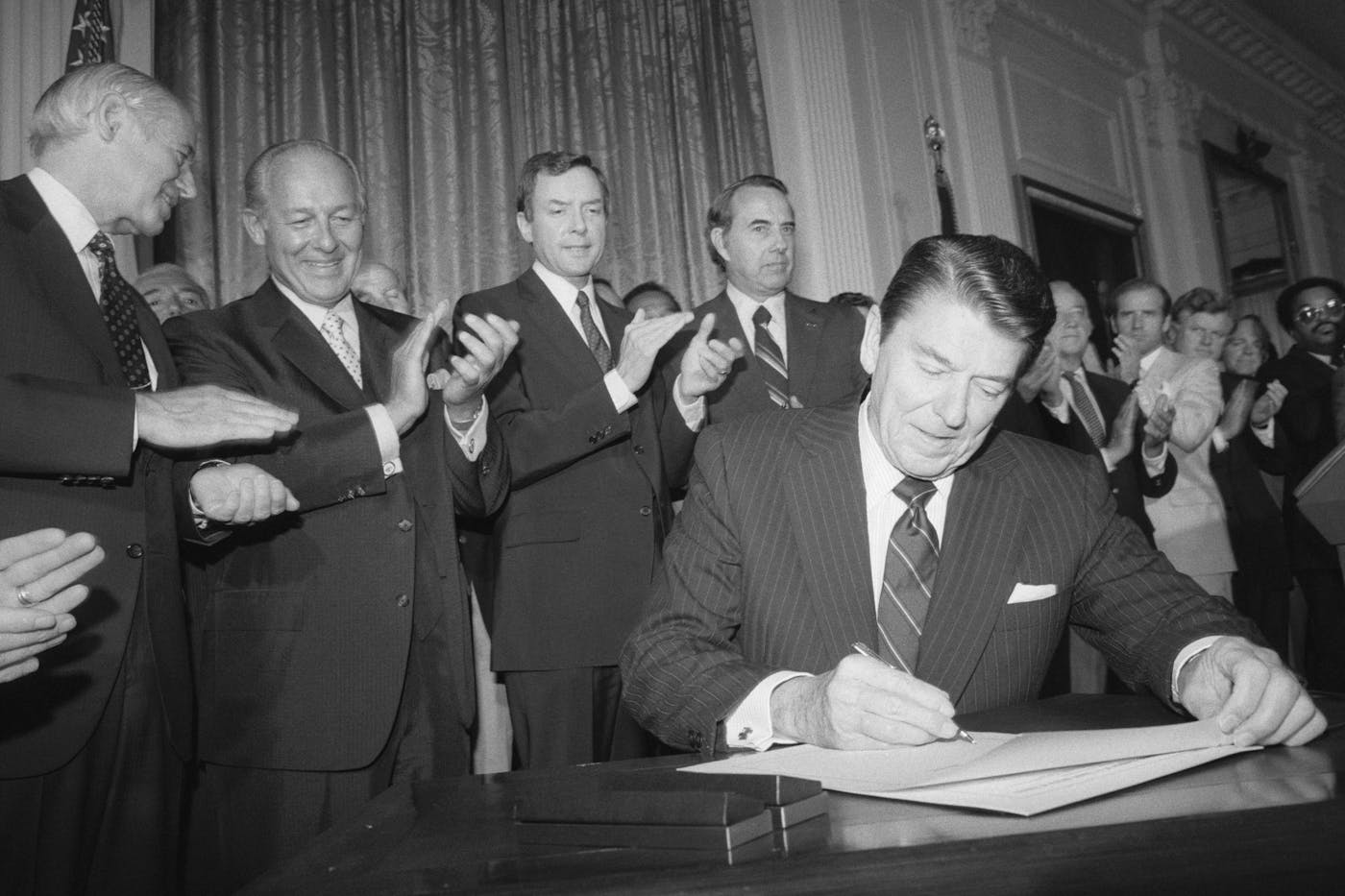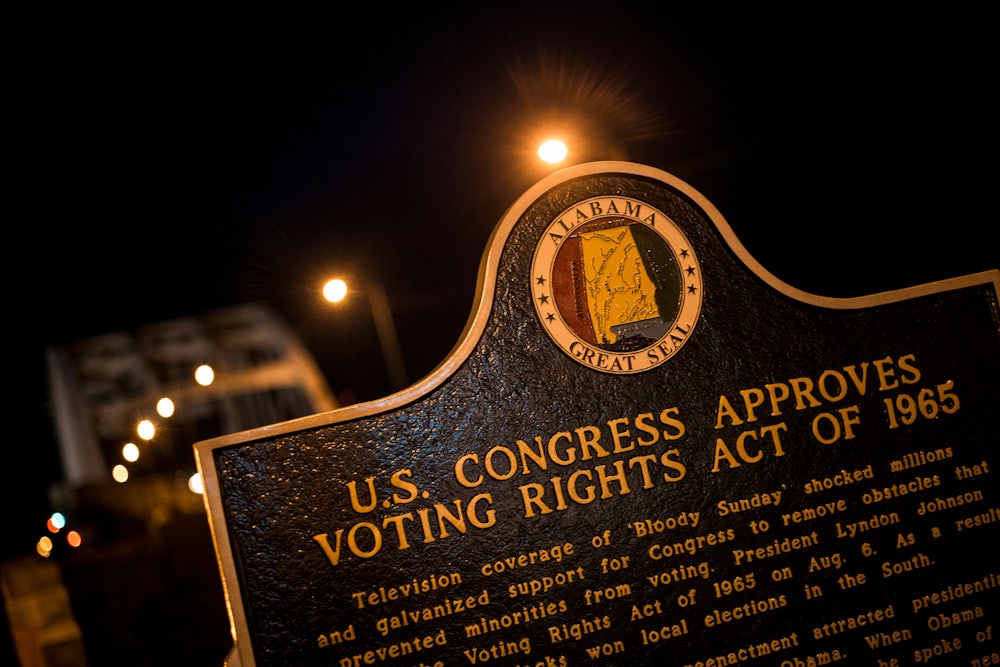The Voting Rights Act of 1965 is now 58 years old. If it were a person, it would be eligible to start making IRA withdrawals without penalties next year. Congress has reauthorized it and amended it multiple times over the last six decades. In 2006, the most recent time lawmakers touched it, the VRA received unanimous and bipartisan support in Congress. It is among the most successful laws ever drafted in the history of the republic. According to the Eighth Circuit Court of Appeals, though, everyone has been reading it wrong the entire time.
A three-judge panel of Republican appointees held earlier this week that private plaintiffs cannot sue states to enforce a key provision of the landmark law known as Section 2, which imposes a permanent, nationwide ban on racial discrimination in election and voting laws. Judge David Stras, a Trump appointee writing for the 2–1 panel, noted that courts had assumed Section 2 was privately enforceable for “much of the last half-century,” but concluded that a “deeper look” had “revealed that this assumption rests on flimsy footing.”
The ruling is contrary to more than a half-century of practice and precedent. If embraced by the Supreme Court, it also threatens to gut one of the last remaining forceful provisions of the Voting Rights Act.
The case, Arkansas State Conference NAACP v. Arkansas Board of Apportionment, is a challenge to alleged racial gerrymandering when the state redrew its state legislative maps for the 2020 Census. Voting-rights groups alleged that the state had engaged in “vote dilution” against Black Arkansans by packing as many of them as they could in certain districts where they form a supermajority, thereby dispersing the rest through other districts where they form a minority.
Stras, in the ruling, treats the plaintiffs’ case with undisguised disdain. “Quarreling over district lines begins like clockwork every ten years after the United States Census,” he wrote, before quickly adding that the “advocacy groups” behind the litigation had “sued nearly everyone who had anything to do with it.” His tone belies the fact that this is generally how litigation works.
When the district court considered the case, it also asked both sides to consider a procedural question: whether the plaintiffs had the right to bring the lawsuit at all under Section 2. That provision is one of the original twin pillars of the VRA—the other being Section 5, which, before the Supreme Court effectively demolished it in 2013, required certain states to submit changes in those laws for preclearance by federal authorities.
Section 2 is enforceable by litigation from the attorney general of the United States. For decades, the courts have also concluded that Section 2 created an implied cause of action—that is, its text implicitly created a right for private parties to bring a lawsuit to enforce it even though it did not explicitly spell it out. The Supreme Court has handed down more than a few rulings since the VRA’s enactment based on this assumption. Congress has also allowed this assumption to persist throughout every reauthorization and amendment.

What fools! They should have run it by the U.S. District Court for Arkansas and the Eighth Circuit Court of Appeals first. Stras discarded the abundant evidence that the VRA’s drafters intended for private parties to be able to sue states under it, dismissing the legislative history as inappropriate for a judge to consider. He also shrugged off the Supreme Court’s ruling in a 1996 VRA case where it decided an implied cause of action existed under a different VRA provision in part because the justices concluded that one existed under Section 2.
“Taken at face value, these statements appear to create an open-and-shut case that there must be a way to privately enforce Section 2,” Stras wrote. “If five Justices assume it, then it must be true. The problem, however, is that these were just background assumptions—mere dicta at most.” Generally speaking, the law is always whatever five justices say it is. But the Supreme Court is also fortunate that it can rely on a panel from the Eighth Circuit to correct its apparent errors and oversights.
One member of the panel recognized how the federal appellate process is actually supposed to work. Chief Judge Lavenski Smith, a George W. Bush appointee, stated the obvious in dissent: Stras and Judge Raymond Gruender, another George W. Bush appointee, are ignoring precedent in favor of predicting how the court might rule in the future. “While that private right has been called into question by two Supreme Court justices, the Supreme Court has yet to overrule itself on that precise issue,” Smith wrote.
In fairness to the panel, it does have some reason to turn to prophecy in this case. Certain members of the Supreme Court have been signaling for conservative judges in lower courts to make this ruling for years. In the 2020 case Brnovich v. Democratic National Committee, the court raised new barriers to Section 2 claims. Justice Neil Gorsuch, in a concurring opinion joined by Justice Clarence Thomas, suggested it should go even further.
“Our cases have assumed—without deciding—that the Voting Rights Act of 1965 furnishes an implied cause of action under Section 2,” he wrote. “Lower courts have treated this as an open question. Because no party argues that the plaintiffs lack a cause of action here, and because the existence (or not) of a cause of action does not go to a court’s subject-matter jurisdiction, this Court need not and does not address that issue today.”
Thomas also flagged that possibility again in a footnote in his dissent from the court’s ruling in Allen v. Milligan earlier this year. “The Court does not address whether Section 2 contains a private right of action, an issue that was argued below but was not raised in this Court,” he obliquely noted. That question did not form the core of Thomas’s argument in that case because, as he has stated often over the last 20 years, he does not think Section 2 should prohibit racial gerrymandering at all.
Those two justices may yet persuade three more of their colleagues to rule against recognizing a private cause of action in Section 2. But they have not done so yet, Smith noted, and so the prevailing precedent should decide the case.
“Until the Court rules or Congress amends the statute, I would follow existing precedent that permits citizens to seek a judicial remedy,” Smith wrote. “Rights so foundational to self-government and citizenship should not depend solely on the discretion or availability of the government’s agents for protection. Resolution of whether Section 2 affords private plaintiffs the ability to challenge state action is best left to the Supreme Court in the first instance.”
Why does it matter if the Voting Rights Act is enforceable by private plaintiffs? If the panel’s conclusion is upheld by the Supreme Court, then Section 2 effectively becomes a light switch. A Republican president—say, Donald Trump—could simply instruct the Justice Department to stop bringing Section 2 lawsuits at all. With no private alternative, that would deal an immense and perhaps irrecoverable blow to voting-rights enforcement in this country.
It’s unclear whether the Supreme Court would go that far. Under Chief Justice John Roberts, the court has been largely hostile to the VRA and its sweeping protections of Americans’ right to democratic governance. But there are also apparent limits to that disdain: Roberts, Justice Brett Kavanaugh, and the court’s three liberals upheld a straightforward Section 2 case on racial gerrymandering in Alabama earlier this year. Since the Eighth Circuit’s ruling is binding unless overturned, we’ll likely soon find out just how far the court’s conservatives are willing to go to demolish the VRA.






